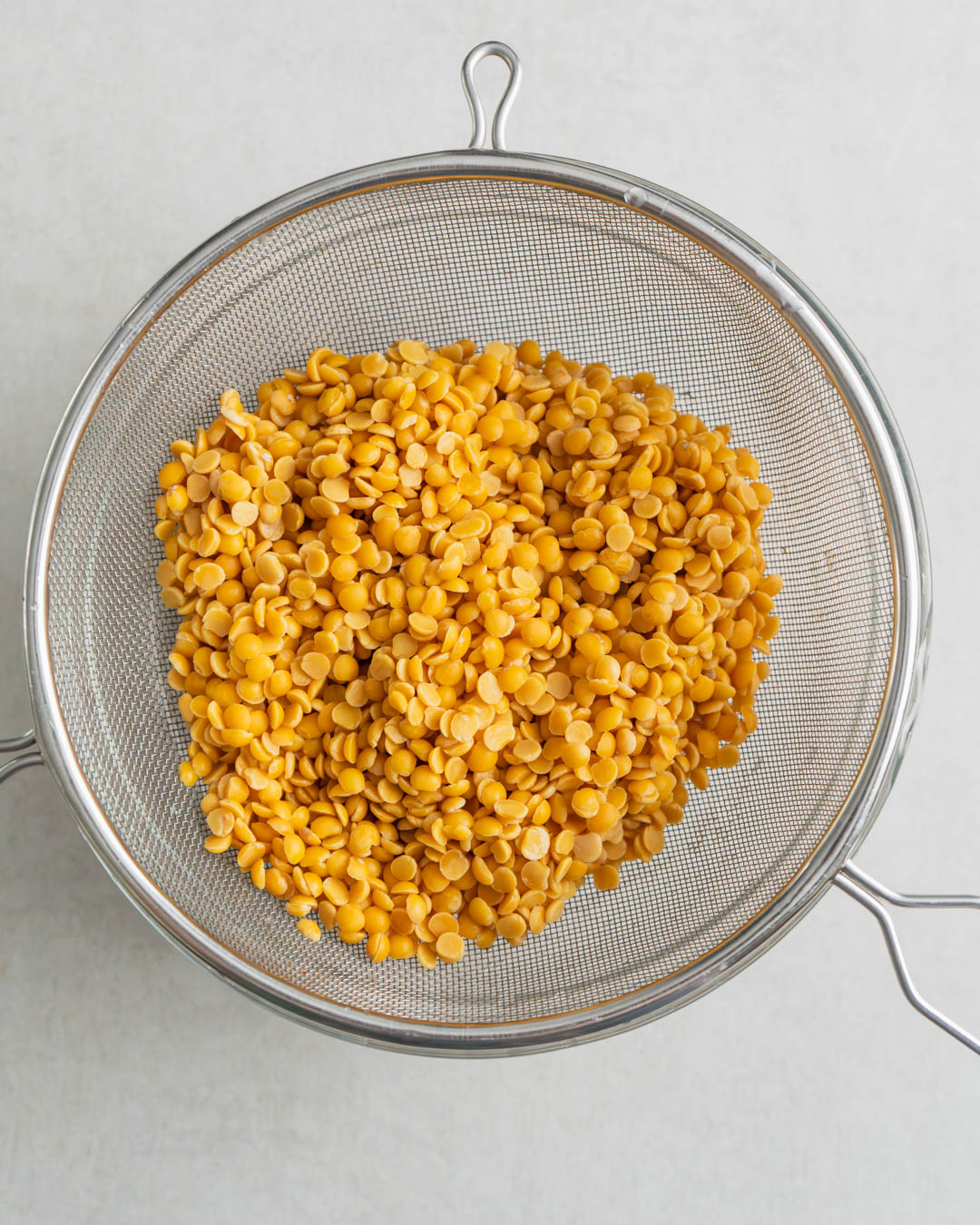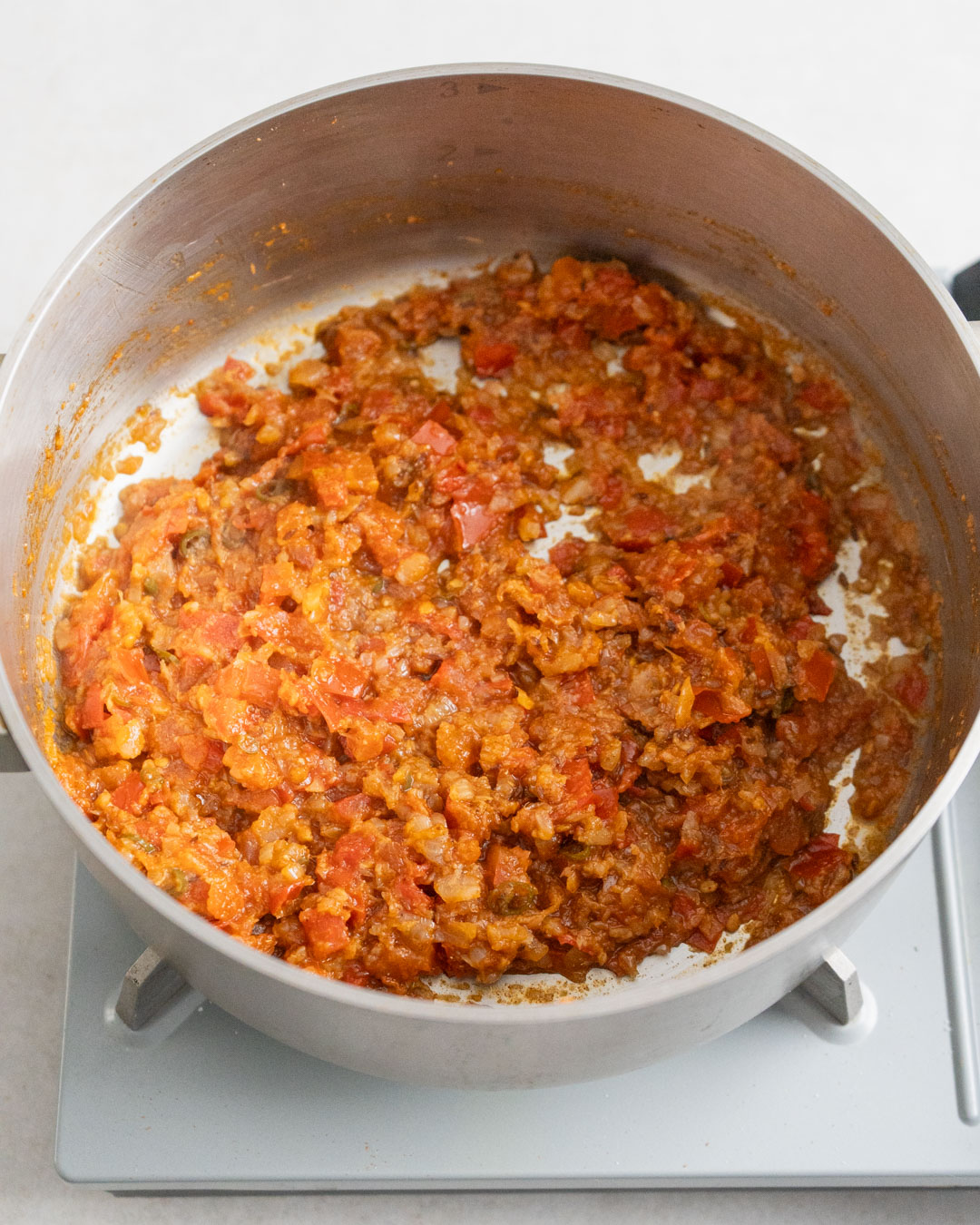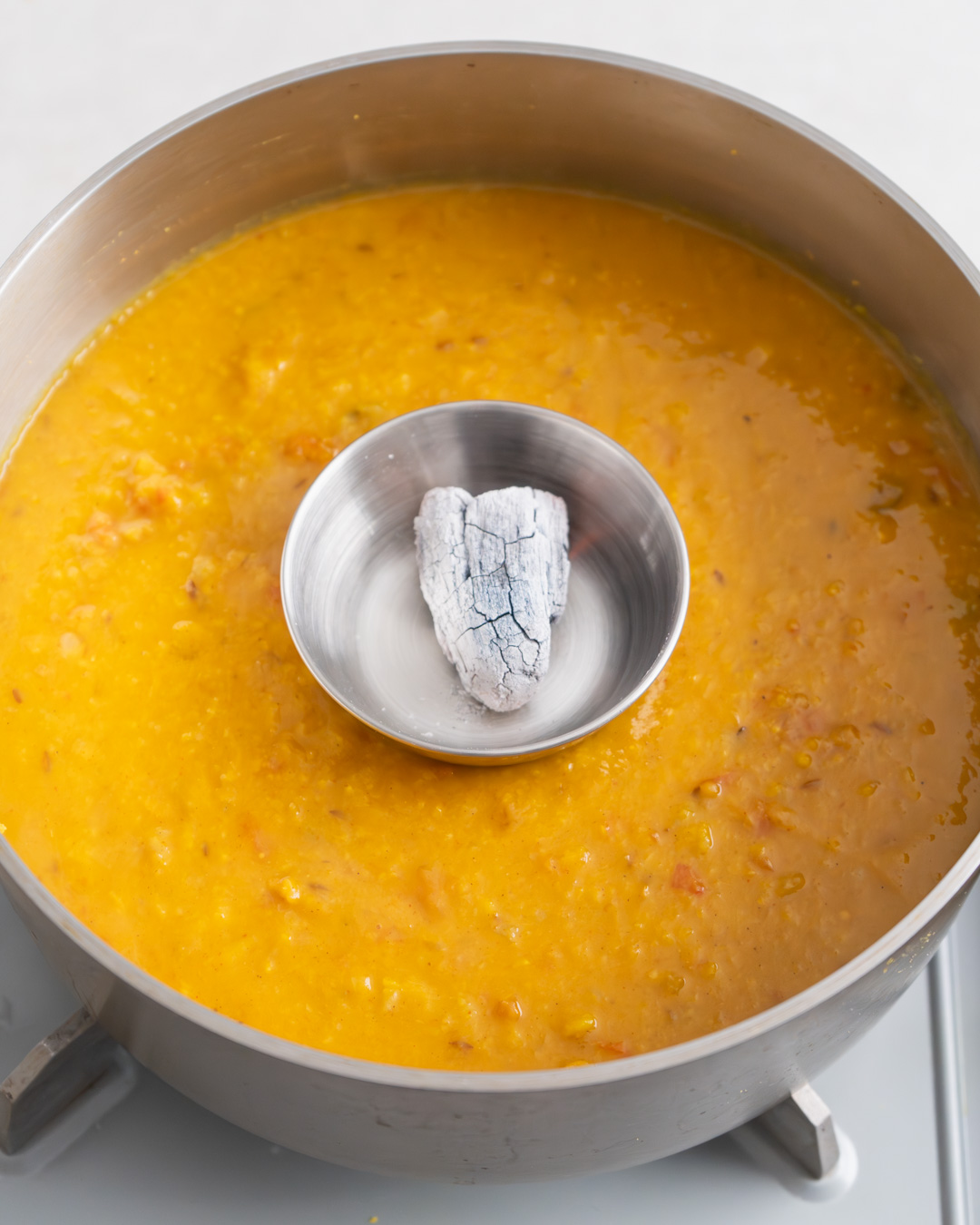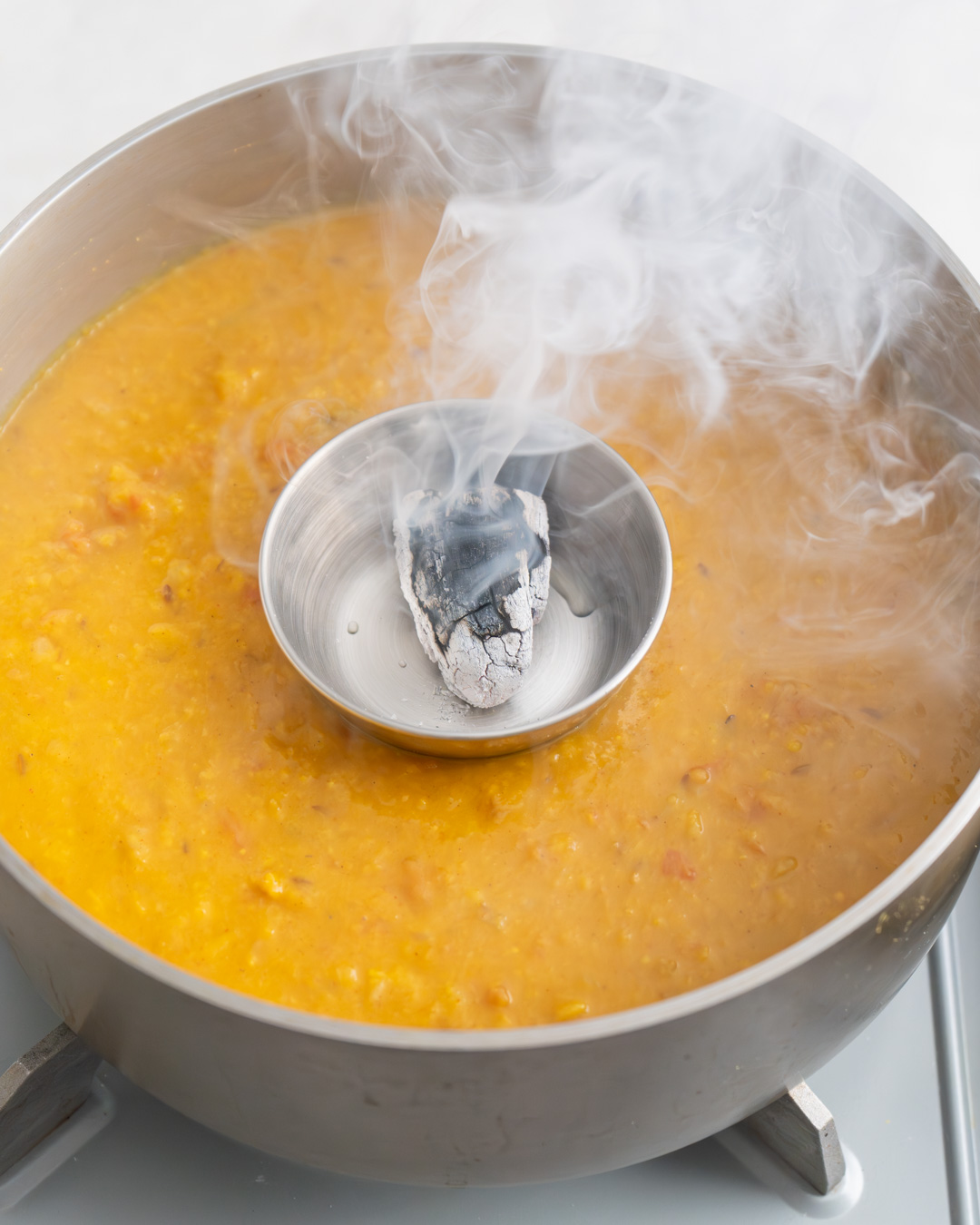Dal Tadka (Indian Restaurant-Style Dal)

What is Dal Tadka?
Dal Tadka is a hearty and flavorful Indian lentil dish made with yellow lentils, typically toor dal (split pigeon peas – a lentil despite its misleading name) or moong dal (split, peeled mung beans) that are cooked until soft and creamy. What sets it apart is the tadka—a fragrant tempering made with oil, cumin seeds, garlic and plenty of Kashmiri chilli powder. This sizzling mixture is poured over the dal, adding layers of spicy and aromatic flavors. Perfect for serving with steamed rice or flatbreads, Dal Tadka is a comforting, traditionally vegan meal that’s easy to make and loaded with plant-based goodness.
History of Dal Tadka
The term dal refers to lentils, pulses, or split legumes, which have been a dietary staple in the Indian subcontinent for thousands of years. Archaeological evidence from the Indus Valley Civilization (circa 2500 BCE) shows that lentils like moong (green gram) and masoor (red lentils) were cultivated and consumed. Pulses were prized not only for their nutritional value but also for their adaptability in various dishes.
While dal dishes have existed for millennia, the addition of tadka likely evolved with the advent of spices in Indian cooking, around the time of the Mauryan Empire (322–185 BCE), when India began trading extensively with the Middle East and Southeast Asia. The spices used in dal tadka—like cumin, garlic, and chilies—became integral to Indian cuisine, influenced by these early trade connections.
Dal Tadka became a versatile and widely loved dish, with each region of India adding its own twist. In North India, the dish is typically made with toor dal (pigeon peas) or moong dal and tempered with cumin and garlic. In South India, variations include curry leaves and mustard seeds in the tempering. Over time, Dal Tadka also gained prominence in Indian restaurants, particularly with the rise of dhabas (roadside eateries) in the mid-20th century, where it became a staple meal.

Restaurant-Style Dal Tadka
At restaurants, chefs usually prepare the tempering over large burners, allowing the flames to reach inside the pan and infuse the tadka with a strong, smoky flavor that gives the dal its unique taste. At home, it is difficult to replicate this technique. Instead, many homecooks use the dunghar method, for which a piece of charcoal is heated until red-hot, placed in a small heatproof bowl and set in the center right on top of the dal. The hot charcoal is then drizzled with a few drops of oil to produce an aromatic smoke, before the pot is quickly covered with a tight-fitting lid to trap the smoke, allowing the aromas to infuse into the dish. This step is of course entirely optional. Dal Tadka without the intense smoky flavor is an equally delicious staple to cook at home.
Ingredients You’ll Need to Make Dal Tadka + Substitutions
Dal
- Toor Dal (Split Pigeon Peas): A lentil despite the misleading name, Toor Dal is the base of the dish, providing a creamy and hearty texture. You can substitute with moong dal or masoor dal for a slightly different flavor and texture. Cooking times may vary.
- Ground Turmeric: Adds a warm, earthy flavor and a beautiful golden color to the dal. No substitute truly matches its unique properties.
- Vegetable Oil: Used for cooking the aromatics. You can use any neutral oil instead.
- Onion: Forms the flavor base, adding sweetness and depth. Red, white, or yellow onions all work well.
- Cumin Seeds: Adds a nutty, earthy flavor that is a signature of Dal Tadka. You can use ground cumin, but you’ll need to add it along with the other ground spices and omit it from the tempering.
- Garlic: Provides a savory aroma to the flavor-base.
- Fresh Root Ginger: Adds warmth and a slight zing to the dish.
- Green Finger Chilies: Bring a gentle heat. You can adjust the number based on your spice tolerance or substitute by adding a little more Kashimiri chilli powder.
- Tomatoes: Add acidity and body, balancing the spices. If fresh aren’t available, use a little bit of tomato paste instead.
- Garam Masala: A warming spice blend that adds complexity and depth. No direct substitute, but a mix of ground cumin, coriander, and cinnamon can work in a pinch.
- Ground Coriander: Adds a mild, citrusy flavor that complements the lentils and other spices.
- Kashmiri Chili Powder: Known for its vibrant red color and pleasant heat. If using normal chilli powder, make sure to use less, since Kashmir chilli is milder.
- Fresh Coriander (Cilantro): Stirred through the dal and used as a garnish, it adds freshness and a burst of flavor. If you don’t like coriander, you can leave it out.
- Lemon Juice: Brightens the dish with a hint of acidity. You can also use a bit of tamarind paste.
- Dried Fenugreek Leaves (Kasuri Methi): Adds a subtle, earthy bitterness and enhances the overall flavor. If unavailable, you can leave them out.
Dunghar (Smoking Technique)
- Natural Charcoal: Key for the dhungar technique, it provides the smoky flavor that elevates the dish to restaurant quality. If unavailable, this step can be skipped.
- Vegetable Oil: Used to generate aromatic smoke when drizzled over hot charcoal. Any neutral oil works perfectly as well.
Tadka (Tempering)
- Garlic: Adds a bold, savory flavor to the tempering, enhancing the overall aroma of the dish.
- Vegetable Oil: Serves as the base for frying the spices, helping to release their flavors. Any neutral oil works well.
- Cumin Seeds: Provide a warm, earthy flavor and a signature nutty aroma when fried. You can use mustard seeds for a different twist.
- Dried Red Chilies: Add heat and a smoky undertone to the tempering, while also making a nice garnish. Try to go for a short variety that fits a small serving bowl. Can be left out.
- Kashmiri Chili Powder: Enhances the tempering with a vibrant red color and mild heat. (Smoked paprika) along with some chilli powder can be used as an alternative for color with a subtle smokiness, especially if not using the dunghar method.
- Asafoetida (Hing): Contributes a deep, umami flavor and aids in digestion. If unavailable, it can be omitted.
How to Make Dal Tadka (Step-by-Step)
Rinse the Dal. Add the toor dal to a bowl and cover it with plenty of water. Stir it with your hands to loosen the starch, then drain and repeat until the water runs almost clear (4–5 times).

Cook the Dal. Add the dal, turmeric and 1l of water to a pressure cooker (to use a normal pan, see Notes, below) and cook for around 4 minutes at full pressure. Leave to depressurise until needed.

Prepare the Base. While the dal is cooking, heat the oil in a casserole over medium heat and peel and finely chop the onion. Fry the cumin seeds in the hot oil until they smell aromatic, then add the chopped onion and continue frying until it begins to turn golden (8-10 minutes). Meanwhile, peel and finely grate the garlic and ginger; trim and finely slice the chillies; dice the tomatoes.
Add Aromatics and Spices. Add the garlic, ginger and chillies to the pan and fry until aromatic.

Tip in the tomatoes and salt and cook until the tomatoes begin to soften (1–2 minutes). Stir in the garam masala, ground coriander and Kashmiri chilli and allow the spices to heat through.

Combine and Simmer. Stir the dal well to break it down until slightly thickened, adding some hot water to loosen it if necessary. Then add the dal to the cooked aromatics, return to a simmer and cook covered for 5 minutes, stirring halfway through, to allow the flavours to develop. Meanwhile, trim and discard the lower stems of the coriander and roughly chop the rest.

Infuse with Smoke (Dhungar). Make sure that the kitchen is well ventilated. Prepare the Dhungar by placing the charcoal over a gas flame until it is white all around (4-5 minutes).

Place a small steel cup in the centre of the casserole, right on top of the dal, and place the hot charcoal inside.

Pour over the vegetable oil to create some smoke, then close the lid and leave to smoke for 3-4 minutes.

Remove the steel cup with the charcoal, then stir in the lemon juice, fenugreek leaves and most of the chopped coriander.

Make the Tempering. For the tempering, peel and finely grate the garlic and have all the remaining ingredients ready. Heat the oil in a small pan over medium heat, then fry the cumin seeds until they begin to sizzle. Stir in garlic and cook for 1 minute more until the garlic is aromatic but not browned. Add the dried chillies and cook for a few seconds more. Turn off the heat and add the kashmiri chilli powder and asafoetida. Stir well to heat the spices through, then pour the tempering over the dal. Stir it through, divide between bowls and sprinkle over the remaining coriander. For a more impressive way to serve, you can also first divide the dal between bowls and spoon some of the tempering over each bowl, followed by the coriander.
Useful Tips
- Dal too thick: Add a splash of water while reheating to get the perfect consistency.
- Dal too thin: Simmer uncovered for a few minutes to thicken.
- Missing smoky flavor: Make sure to use an airtight lid and try to leave it to infuse for a little longer.
- Enhanced Flavor: Prepare the dal a day ahead. The flavors, especially the smoky aroma, deepen as it sits, making it even more delicious the next day. Just make sure to reheat it with a splash of water as it will thicken overnight.
- Pressure Cooker: With the help of a pressure cooker, it only takes 4 minutes to cook the lentils. You can then let it depressurise naturally while you carry on with the recipe.
- No Steel Cup for the Dunghar Method: You can make a makeshift cup out of aluminium foil, or even place the charcoal in a hollowed out onion half.
Why You’ll Love This Recipe
- naturally vegan
- easy to make
- unique smoky flavour
- nutritious and wholesome
How to Store Dal Tadka
- Refrigerator: Store in an airtight container for up to 4 days.
- Freezer: Portion the dal into freezer-safe containers or bags, and freeze for up to 3 months. Thaw in the fridge overnight before reheating.
- Reheating tips: The dal will thicken in the fridge, so reheat it with a generous splash of water to reach the desired consistency. For a fresh touch, you can prepare a quick tadka to drizzle over before serving.
Other Indian Recipes You Might Like
- Sambar: a tangy and spicy lentil and veg stew that’s usually eaten for breakfast
- Uttapam: thick, fluffy pancakes topped with topped with tomato and a spicy “gunpowder” mix
- Kuzhi Paniyaram: crispy balls made from fermented idli rice and urad dal
**I receive a small commission from affiliate links on this page**

Dal Tadka (Indian Restaurant-Style Dal)
Equipment
- 1 Pressure Cooker, (I recommend Fissler Vitavit Premium 3.5l or larger), optional
- 1 Small Steel Cup, (optional)
Ingredients
Dal
- 320 g toor dal
- 1 tsp ground turmeric
- 3 tbsp vegetable oil
- 1 large onion (200g)
- 1 tsp cumin seeds
- 3 large garlic cloves
- 30 g fresh root ginger
- 2 green finger chillies
- 2 large tomatoes (300g)
- ¾ tbsp salt (10g)
- 1 tsp garam masala
- 1 tsp ground coriander
- 1/2 tsp kashmiri chilli powder
- 30 g coriander
- 1 tbsp lemon juice
- 1 tsp dried fenugreek leaves
Dunghar (Smoking Technique)
- 1 piece natural charcoal
- 1/2 tsp vegetable oil
Tadka (Tempering)
- 1 large garlic clove
- 3 tbsp vegetable oil
- 1 tsp cumin seeds
- 2 dried red chillies
- 1 tsp Kashmiri chilli powder
- ¼ tsp asafoetida
Instructions
- Add the toor dal to a bowl and cover it with plenty of water. Stir it with your hands to loosen the starch, then drain and repeat until the water runs almost clear (4–5 times).
- Add the dal, turmeric and 1l of water to a pressure cooker (to use a normal pan, see Notes, below) and cook for around 4 minutes at full pressure. Leave to depressurise until needed.
- While the dal is cooking, heat the oil in a casserole over medium heat and peel and finely chop the onion. Fry the cumin seeds in the hot oil until they smell aromatic, then add the chopped onion and continue frying until it begins to turn golden (8-10 minutes). Meanwhile, peel and finely grate the garlic and ginger; trim and finely slice the chillies; dice the tomatoes.
- Add the garlic, ginger and chillies to the pan and fry until aromatic, then tip in the tomatoes and salt and cook until the tomatoes begin to soften (1–2 minutes). Stir in the garam masala, ground coriander and Kashmiri chilli and allow the spices to heat through.
- Stir the dal well to break it down until slightly thickened, adding some hot water to loosen it if necessary. Then add the dal to the cooked aromatics, return to a simmer and cook covered for 5 minutes, stirring halfway through, to allow the flavours to develop. Meanwhile, trim and discard the lower stems of the coriander and roughly chop the rest; prepare the Dhungar by placing the charcoal over a gas flame until it is white all around (4-5 minutes). Make sure that the kitchen is well ventilated for this method.
- Place a small steel cup in the centre of the casserole, right on top of the dal, and place the hot charcoal inside. Pour over the 1/2 teaspoon of vegetable oil to create some smoke, then close the lid and leave to smoke for 3-4 minutes. Remove the steel cup with the charcoal, then stir in the lemon juice, fenugreek leaves and most of the chopped coriander.
- For the tempering, peel and finely grate the garlic and have all the remaining ingredients ready. Heat the oil in a small pan over medium heat, then fry the cumin seeds until they begin to sizzle. Stir in garlic and cook for 1 minute more until the garlic is aromatic but not browned. Add the dried chillies and cook for a few seconds more. Turn off the heat and add the kashmiri chilli powder and asafoetida. Stir well to heat the spices through, then pour the tempering over the dal. Stir it through, divide between bowls and sprinkle over the remaining coriander. For a more impressive way to serve (see picture), you can also first divide the dal between bowls and spoon some of the tempering over each bowl, followed by the coriander.
Video
Notes
- To make the dal in a normal pan, wash it as described above, then cover with water and leave to soak for 30 minutes. Drain, transfer to the pan together with the turmeric and 1l of water, bring to boil, then reduce the heat and simmer covered for 45 minutes or until tender and easily breaking apart. Continue with the rest of the recipe.
- If you don’t have a steel cup, you can make a makeshift cup out of aluminium foil, or even place the charcoal in a hollowed out onion half.
- Serve with rice or flatbreads.
- Storage: Refrigerate in an airtight container for up to 4 days.

Absolutely fantastic! I can’t believe how smoky and amazing it turned out! Your recipes are wonderful! Thank you for sharing them
So great that you gave it a go and it turned out well! Love that!
Love it!
That’s wonderful to hear, thank you! ☺️
Can I throw in some smoked paprika or liquid smoke to get the same effect.
You can for a little bit of a smoky flavor, but the charcoal adds quite a distinctive aroma. It’ll be delicious either way, though!
Love your content and also i wanted to point out a little mistypo in kashmiri chili powder section (normal cili powder instead of normal chili powder)
Thank you so much, I’ve changed that now!
I’ve made this a few times. It’s delicious. Thank you for sharing your fantastic travels and wonderful recipes. I love them <3
Thank you so much for giving it a go!
I’ve made this a few times. It’s delicious. Thank you for sharing your fantastic travels and wonderful recipes. I love them <3
This came out wonderfully flavorful and so satisfying! I don’t have a pressure cooker so this took about two hours. I passed the toor dal through a sieve after cooking to make it smooth, and served this with rice, naan, and chili oil made with lots of toasted peanuts.
That sounds perfect! And yes, just keep it cooking until the desired texture ☺️